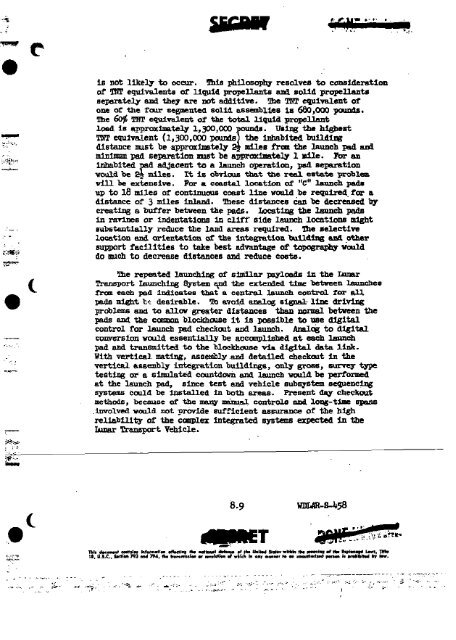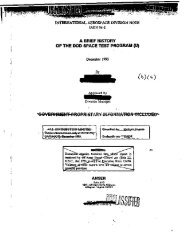LUNAR EXPEDITION PLAN
LUNAR EXPEDITION PLAN
LUNAR EXPEDITION PLAN
Create successful ePaper yourself
Turn your PDF publications into a flip-book with our unique Google optimized e-Paper software.
e<br />
1E not likely to occur. Skis philosophy resolves to consideration<br />
of THT equivalents of liquid propellants and solid propellants<br />
separately and they are not additive. Ihe THT equivalent of<br />
one of the four segmented solid assemblies is 680,000 pounds.<br />
The 60$ TNT equivalent of the total liquid propellant<br />
load 1B approximately 1,300,000 pounds. Using the highest<br />
TNT equivalent (1,300,000 pounds) the inhabited building<br />
distance must be approximately 2| miles from the launch pad and<br />
minimum pad separation must be approximately 1 mile. For an<br />
inhabited pad adjacent to a launch operation, pad separation<br />
would be Q§ miles. It Is obvious that the real estate problem<br />
will be extensive. For a coastal location of "C" launch pads<br />
up to 18 miles of continuous coast line would be required, for a<br />
distance of 3 miles inland. 3hese distances can be decreased by<br />
creating a buffer between the pads. Locating the launch pads<br />
in ravines or indentations In cliff side launch locations might<br />
substantially reduce the land areas required. The selective<br />
location and orientation of the Integration building and other<br />
support facilities to take best advantage of topography would<br />
do much to decrease distances and reduce costs.<br />
Hie repeated launching of similar payloads in the lunar<br />
Transport Launching System and the extended time between launches<br />
from each pad indicates that a central launch control for all<br />
pads might tt desirable• To avoid analog signal- line driving<br />
problems and to allow greater distances than normal between the<br />
pads and the common blockhouse it is possible to use digital<br />
control for launch pad checkout and launch. Analog to digital<br />
conversion would essentially be accomplished at each launch<br />
pad and transmitted to the blockhouse via digital data link.<br />
With vertical mating, assembly and detailed checkout In the<br />
vertical assembly integration buildings, only gross, survey type<br />
testing or a simulated countdown and launch would be performed<br />
at the launch pad, since test and vehicle subsystem sequencing<br />
systems could be Installed in both areas. Present day checkout<br />
methods, because of the many manual controls and long-time spans<br />
involved would not provide sufficient assurance of the high<br />
reliability of the complex Integrated systems expected In the<br />
Lunar Transport Vehicle.<br />
8.9 WDDAR-S-U58<br />
Till dxtmwit contain Me«**l« efhtctln* Ma nattoMl aMm* af |h> UaUad Hat* wMatn It* mini •» IW baiaiMff* lawt, TM*<br />
II, U.S.C, SMlM 713 «d 794, Hw frwnfflulaa «r lanfetln at vhtcb In any H U H fa an amttiarltMl aarHa f» »>aklUM *T law.




